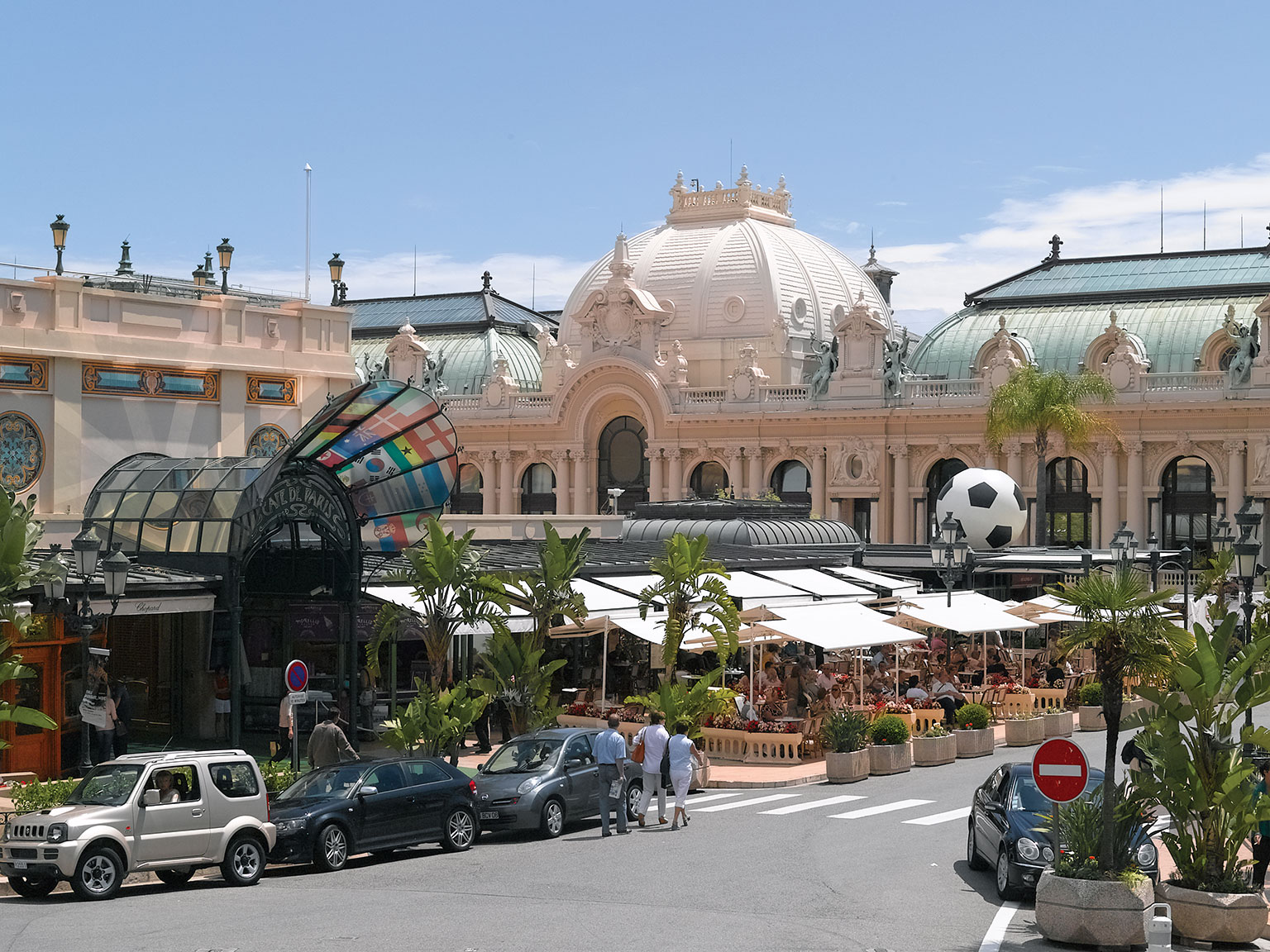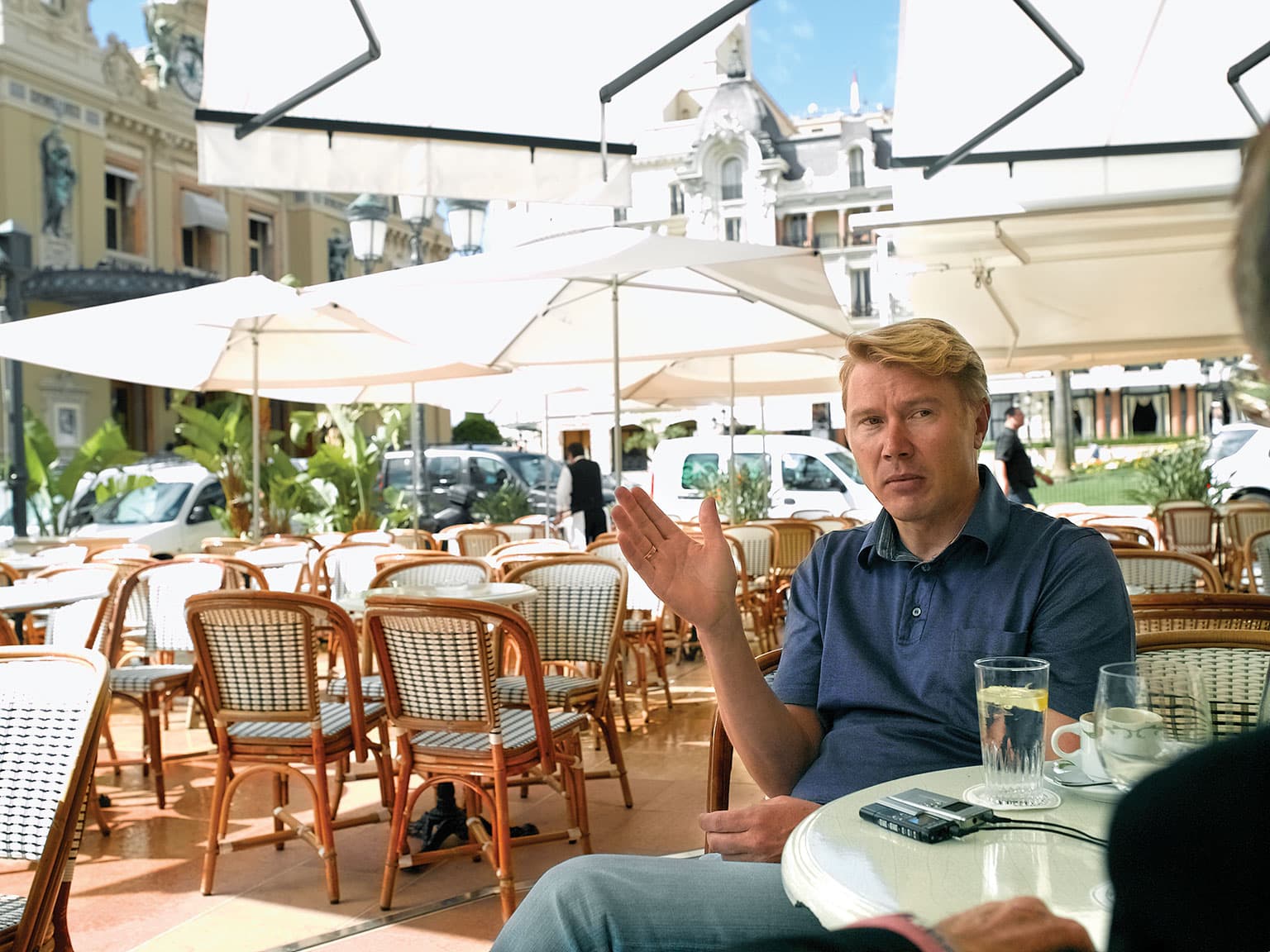Lunch with... Mika Häkkinen
This double World Champion had a long wait for his first Grand Prix victory. But he never lost his self-belief, even after staring death in the face
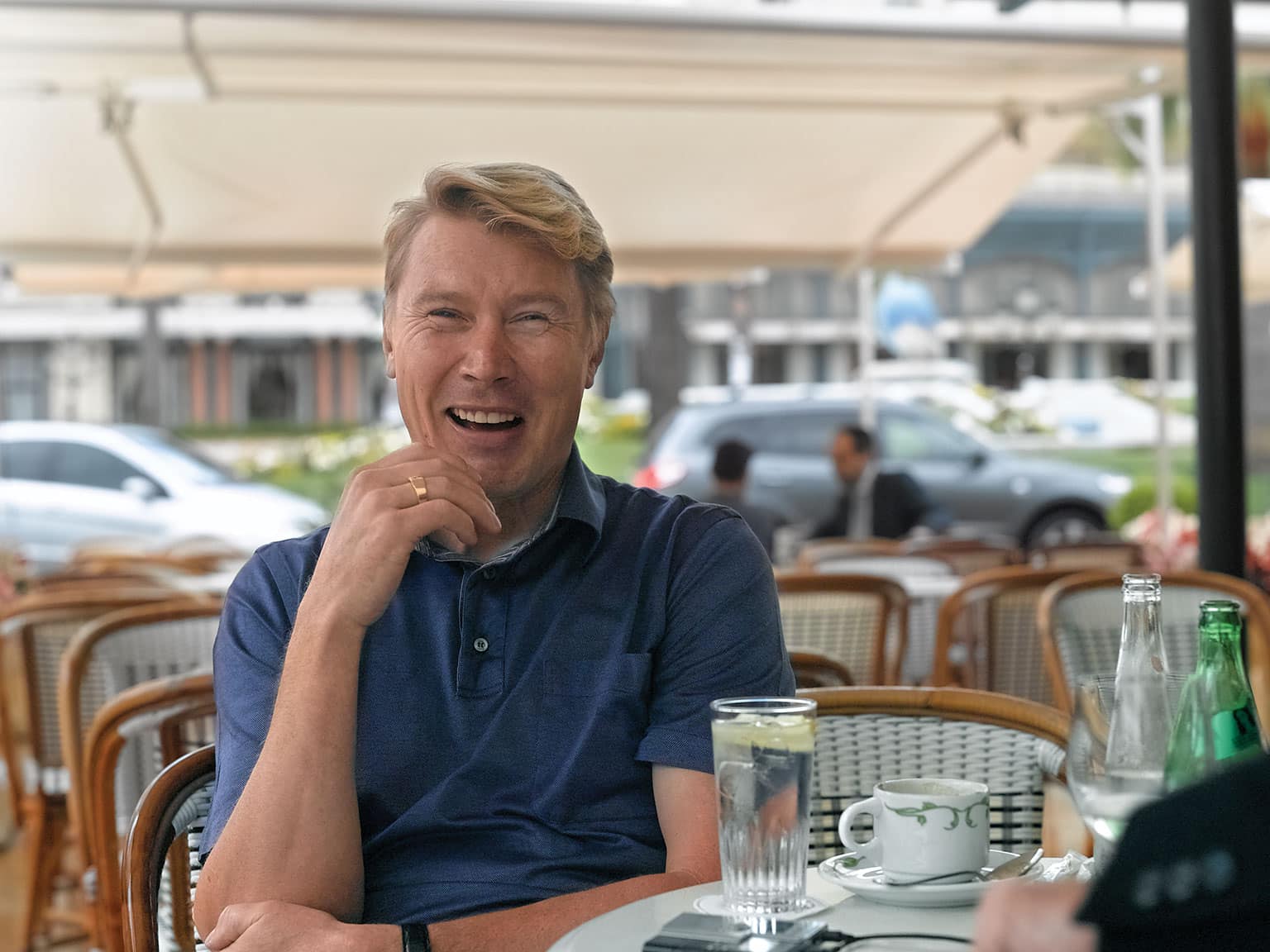
James Mitchell
Win the World Championship, and you become a hero for life. Damon Hill, Nigel Mansell, Keke Rosberg, Alan Jones, Jody Scheckter, James Hunt: unforgettable names who won the F1 title just once, enough to place them for ever among racing’s greats.
But today I’m spending time with a man who won the World Championship two years on the trot. Even so, his name doesn’t come immediately to many people’s minds when they think of the top racers of the past 20 years. Maybe it’s his quiet, self-deprecating manner – although, in his long, difficult rise to the top, his unshakeable self-belief was always a strong asset. Given his blinding speed and will to win, it’s extraordinary that he had to endure seven hard seasons, 98 Grands Prix and a near-fatal accident before he could score his first victory. But that uncorked the bottle: a year later, he was World Champion. He went on to entertain us with a string of wonderful battles with Michael Schumacher, becoming, as Schumacher says now, the driver he regarded as his most indomitable rival.
Today Mika Häkkinen is 41, a relaxed, contented man with a Monaco apartment, a country house in France and an island holiday retreat in his native Finland. We meet in the Café de Paris in Monte Carlo. The familiar sweep of the F1 circuit, swinging through Casino Square and past us down the hill to Mirabeau, looks very different on this busy summer weekday. A Rolls Royce Phantom draws up silently in front of the Hotel de Paris; expensive ladies click past on expensive high heels bound for expensive lunches; an au pair collects toddlers from playschool in the household Bentley Azure.
It’s very different from how Mika’s life began, in a small apartment just outside Helsinki. His parents were ordinary working people: his father, a shipping radio operator, also did spare-time taxi-driving to help pay for Mika’s karting. Having tried (and crashed) a rental kart at the age of five, Mika pestered his parents until, at six, they bought him a second-hand one of his own. He drove this relentlessly at his local track until he was 12, then the minimum racing age in Finland. His first national class title came the next year. Shy and tongue-tied, in a kart he was devastatingly quick and aggressive. Already this kid from a small country near the Russian border had quietly, inside his head, set his sights on becoming World Champion. At 14 he won the first of four consecutive Finnish kart titles.
In 1987, now 18, Mika moved up to Formula Ford, buying a second-hand Reynard from local hero JJ Lehto. He took it all over Scandinavia in an old bus, and swept the board. That year he won the Swedish, Finnish and Scandinavian FF titles, and beat most of the lap records set by Lehto in the same car. “I was very naïve. I believed nobody could drive faster than I could. I had so much self-belief that, even when I had a bad result, I knew the next race was coming, and I was going to win that one. I was quite happy living in the bus. All through my karting we’d always camped. That was my life. If I’d had to go into a five-star hotel I’d have been terrified.”
He ventured south to a couple of Euro Championship rounds too, taking pole at Zandvoort but crashing, and winning at Zolder. Then the old bus crossed the channel to Brands Hatch and the Formula Ford Festival. Reynard lent him a current car: he didn’t get its handling to his liking, and crashed in the semi-final. But he was summoned to Donington by Marlboro, who’d heard about this fast Finn and wanted to take a look at him. So he chugged up the M1 in the bus. He’d just had his 19th birthday, and at this stage spoke almost no English.
The panel at Donington to decide the recipients of the next season’s Marlboro money included McLaren’s Ron Dennis and ex-World Champion James Hunt. Mika was put in an FF2000 and given a target time. Sampling wings and slicks for the first time, he turned in a string of blistering laps, well under the target. At once he was signed as a Marlboro driver, with a seat in a Vauxhall/Lotus for 1988.
Run by Dragon Motorsport, he won the 10-round Euroseries with victories at Spa, Zandvoort and Ricard, and was runner-up to team-mate Allan McNish in the British series – despite an enforced return home to fulfil his National Service. Next stop F3: for 1989 McNish moved to Dick Bennetts’ highly experienced West Surrey Racing, while Mika opted to stay with Dragon, which was moving up to F3 for the first time. At the first round, at Thruxton, Mika qualified 16th, finished 15th. It was a disaster.
“We had a new chassis from Reynard, a new engine from Toyota, and I said to myself, ‘This will be a great year, we’re going to win.’ But from the start there were problems. I had no F3 experience, of course, but the team didn’t either. No data, just a clean sheet of paper. My god, it was tough. I was trying my best, working my butt off to try to understand what was going on here. Basically I was panicking because McNish, with the Ralt chassis and the Mugen engine and all the West Surrey experience behind him, was winning the races. I still had all my self-belief, but nobody in the racing world was saying, ‘Relax, Mika, it’ll all come right.’ They were saying, ‘Mika, you better go back to Finland.’
“But, you know, it was actually an important year for me. Because it taught me to work hard, whatever the results, learn to deal with disappointment and keep motivated. I got a lot out of that tough season. The guys at Dragon, I remember them all, and I owe them just as much as I owe the guys from the good years. At the end of the year Marlboro wanted to find out: has this guy lost the plot, or does he still have the balls to go flat out? So for the Superprix at Brands Hatch they put me in the West Surrey Ralt. I tested it at Snetterton, and at once I knew, this is a different world, now I know how it’s meant to feel. You change the rollbar a little bit, you feel it in the balance at once, everything is logical.” He started from pole, won the race and set a new F3 lap record. The point was made.
So for 1990 he did F3 with West Surrey, beside Christian Fittipaldi. He carried all before him, winning the British F3 Championship by 23 points (from countryman Mika Salo). “At first Christian didn’t understand me. He was from Brazil, hot-blooded, big smile, let’s all go to dinner. I was from Finland, not very open, a cold person like metal. Part of it was my shyness, but I didn’t come to make friends, I came to win races. But once we learned to understand each other we got on fine. When I won the series we had a great night out. We had so much fun that I can’t remember it, and it’s probably better that I don’t.”
Bennetts also took him to Continental races at Imola and Hockenheim, and he won them both. “Hockenheim was a round of the German F3 Championship, and I came up against Michael [Schumacher] for the first time. He was the hero there. In first qualifying I had a misfire and I was two seconds off the pace. All the German F3 guys sneered at us, saying: ‘F3 in England is slower than here.’ In the second qualifying I got a massive tow and took pole, 1.1sec faster than Schumacher. Everybody thought we’d cheated. I led the race start to finish, broke the lap record, Michael was only second. We took our trophy, sprayed our champagne, and went home.”
But at Macau a month later Mika got it wrong. The race was in two heats: from pole, he beat Schumacher by a clear 2.7sec in the first part, so all he had to do was stay close behind him in part two to be overall winner. But the racer in Mika wanted to win both parts. On the final lap he attacked. Schumacher moved to block him and Häkkinen clipped him, spinning off into mortified retirement.
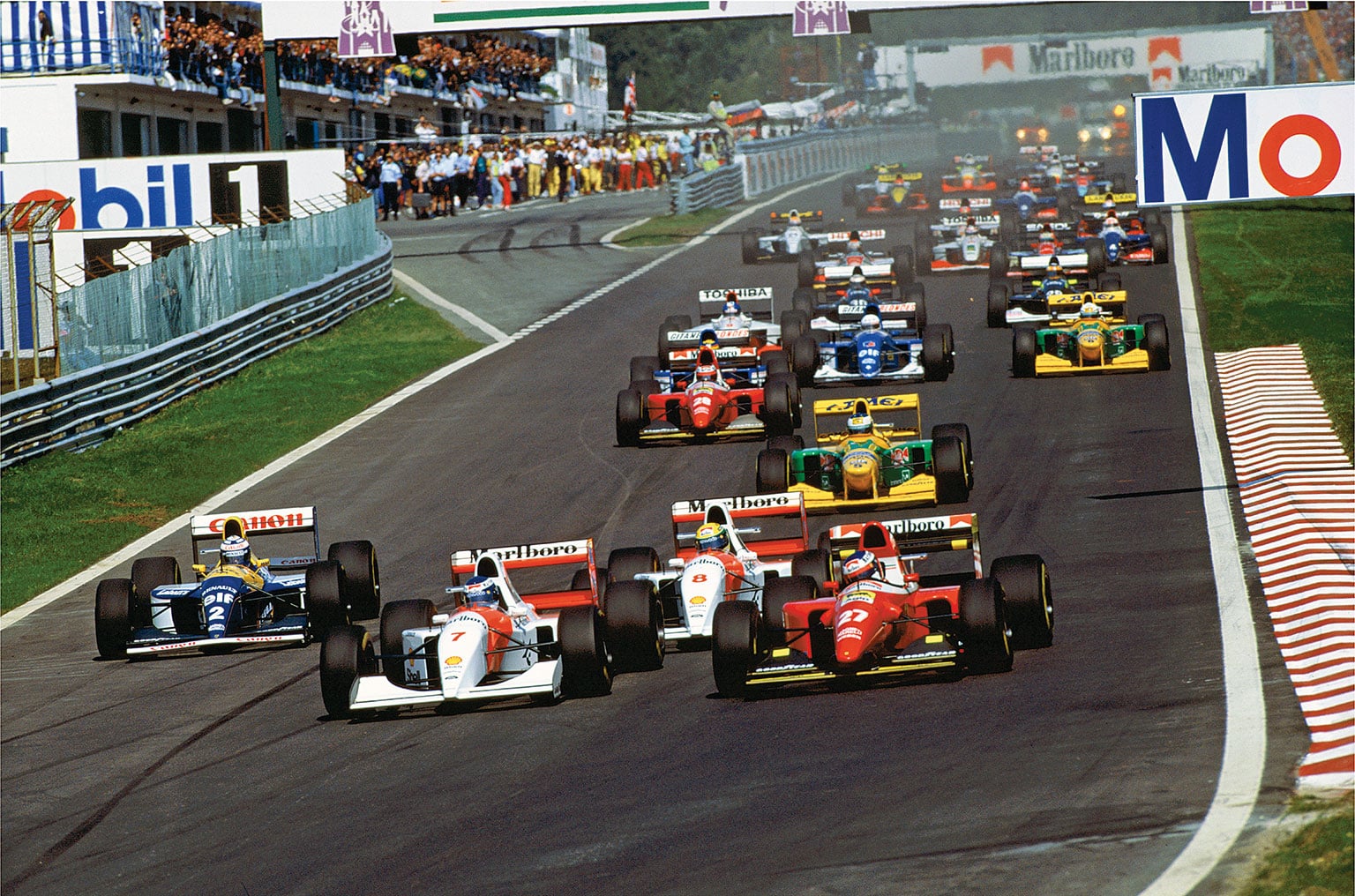
Leading an angry Senna on his debut for McLaren at Estoril 1993
Motorsport Images
*
After the Superprix win, Benetton gave Mika an F1 test at Silverstone. “I didn’t really fit in the car, my elbows were pushed against the cockpit sides and it was difficult to change gear. But as soon as I drove out of the pits, the steering so precise, the throttle response so instant, exactly the message from my hands and my feet straight to the road, I thought, ‘This is what I am made for. This is my world, my business.’ Alessandro Nannini came in by helicopter and did a few laps to set the car up and then left, and I did 90 laps and beat his time. But I didn’t expect to be offered a drive, I knew I still had to win in F3 first.” Having done that, he moved straight into F1 with Lotus.
These were troubled times for Team Lotus. Peter Collins was keeping it afloat using an update of the old 102 and Judd engines. It wasn’t very competitive and funds were tight, but Mika felt at home in F1 straight away. In his first race, Phoenix, he qualified 13th, and in his third, Imola, he finished fifth. His first team-mate was Julian Bailey. “Julian was a great character. He was older than me, and I learned a lot from watching how he worked with the team, how he talked to the sponsors. Everybody liked him. I was shy, but also I was sometimes a bit arrogant, because I believed in myself so much. Now I was learning that it’s not enough just to sit in the car and drive fast. You have to communicate with the people you work with.”
After four races Bailey was replaced by Johnny Herbert. “Peter Collins was very close to Johnny, ever since they’d been together at Benetton, and I sensed that Peter really wanted him to do well. Suddenly I’d become the other driver, which brought my morale down. Later on, when I grew up more, I didn’t need so much attention. But then I was young, I needed approval to help me do my job. Peter told other people he thought I was fantastic, but he never said it to me. I liked Peter, for a while I was even living with him and his family, but he was under big pressure trying to keep the team going, and it was very difficult for him. For 1992 we had the Ford HB engine, which was a big step forward.” That year Mika qualified in the top 10 six times, finished in the points six times and earned two fourth places, finishing eighth in the championship.
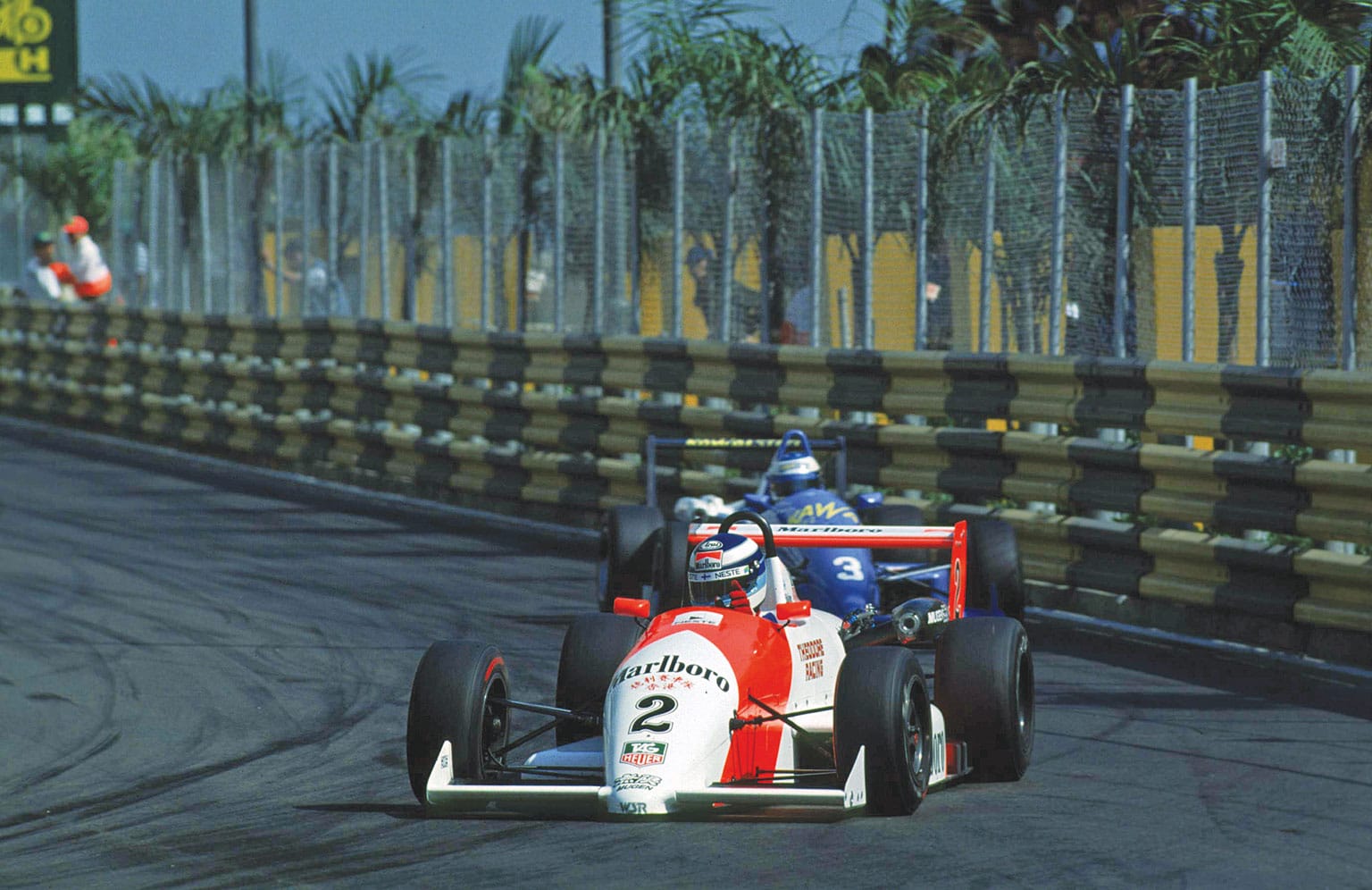
Macau 1990, where Hakkinen won one heat, but clashed with Schumacher in the second
Motorsport Images
For 1993 he was approached by Ron Dennis – who’d been watching him since that teenage Donington test five years before. “I had a meeting with Ron and I was very nervous, because I knew what McLaren meant and how well they operated. Ron said to me, ‘Are you the best?’ I said, ‘Yes, I am.’ He said, ‘Will you win races?’ I said, ‘Yes, I will.’ We didn’t talk long.”
But for Mika it was a risky move. Ayrton Senna was haggling over whether to do a sixth season with McLaren and, with Michael Andretti already signed as number two, Mika was nothing more than Ron’s long-stop if the Senna deal didn’t get done. And it was done, literally at the eleventh hour. Mika found himself demoted to a testing role. “Everybody said I’d made the wrong move. Even my parents said, ‘That’s it. Now you’re just a test driver.’ But inside I believed it was going to be OK.” Andretti’s F1 career was not a success, but it was late September before he headed home to America. The season had just three races left, starting with Estoril.
“Although I’d been testing all season, I’d never been up against Ayrton on equal terms. Always the set-up was different, the fuel levels or the tyres were different. I kept saying, ‘Give me some fresh tyres, put me on low fuel, let me have a go at a real time,’ and they’d say, ‘No, no, Mika, you stick with the programme.’ And it was difficult to learn anything from Ayrton. He always kept his distance, he didn’t want me to listen to his debriefs. If he was asked to show me data he would just give me a piece of paper, but he didn’t want to talk about it. It was his way.
“At Estoril I qualified third. Faster than Ayrton. He couldn’t understand it. Same tyres, same fuel level, same engine, same aero, everything the same. He was so angry. I was in the press conference, he wasn’t. All the media were excited, but I didn’t say much. I just said, ‘This is why I came here, to be fast.’ Afterwards Keke Rosberg, who was my manager then, said, ‘Why were you so quiet? You had a great opportunity to show everybody who you are.’ But I said, ‘No point waving my arms around. It was only qualifying. I keep my hands down until I win.’
“Then I went back to the motorhome. There was a corner where I was quicker than Ayrton, and he asked me – it was the first time he’d asked me anything – ‘How do you do that corner?’ So I just held my cupped hands up in front of him, to say, big balls. He was so pissed off with that. He shouted at me, ‘How many races have you won? How many World Championships? How many pole positions?’ He went through the whole list. I said, ‘It was just a joke, Ayrton.’ But for him it was no joke. He was angry with me for weeks after that.

The shy driver is all smiles after winning the 1990 British F3 title with WSR
Motorsport Images
“For the race Ayrton decided to take a different spec engine with the torque curve at a different rev-range. And he flew – but his new engine blew up. I hadn’t done an F1 race for 11 months, so I was really lacking race experience. I was chasing Jean Alesi for third place, and I went off. His Ferrari V12 had more grunt than my Ford V8, so the only way I was going to pass him was to get in his tow onto the main straight and outbrake him into the first corner. Coming onto the straight I was very close behind him, and I lost downforce and went wide. A little ditch in the grass launched me, and I crashed.
“So after that race Senna didn’t speak to me, and Alain Prost didn’t speak to me either, because I wasn’t very nice to him at the start.” In the first corner Mika shut the door on the World Champion elect, pushing him onto the grass and displeasing him no end. “I was a young guy at a moment in my life, but all the other drivers, they thought I was crazy. But they took me seriously after that.” At the next race, Suzuka, Mika qualified third behind Prost and Senna, and finished third; in Adelaide he was running third when a brake pipe fractured.
“For the next year Ayrton had gone to Williams. Now I was number one at McLaren with Martin Brundle, but we had the Peugeot engine. I had to work really hard to try to get results. What I had learned from Ayrton was that even the biggest talent is not enough. You have to work hard as well to be successful. Always Ayrton worked, worked incredibly hard. Nobody is born a winner. It’s a lot of work, a lot of discipline, a lot of sacrifice.”
Despite the Peugeot’s unreliability, Mika scored a second and five thirds, and ended up fourth in the points. But his reputation preceded him. At Silverstone he and Rubens Barrichello collided on the last lap, and the FIA handed both a one-race ban, suspended for three races. At the next Grand Prix, at Hockenheim, he was involved in a first-corner pile-up that took out six cars. The FIA decided he was the instigator of “an avoidable accident”. Mika maintained he was squeezed between Coulthard’s Williams and Blundell’s Tyrrell, and could do nothing about it. “I was aggressive, yes, everybody knew this, and people decided I needed a slap on the wrist. So I was banned from one race, Hungary. But in fact it turned into a big change in my career. Everybody said, ‘Chill out, Mika, you need to relax.’ So I took their advice, and I think it was a mistake. Even today I regret that. By the time I was racing Michael for the championship, I was more relaxed than him. I should have carried on with my own way of working, I should have continued to go for it everywhere and stayed aggressive. If I’d done that I would have been a different guy against Michael. But after you’ve changed your attitude you can’t go back.”
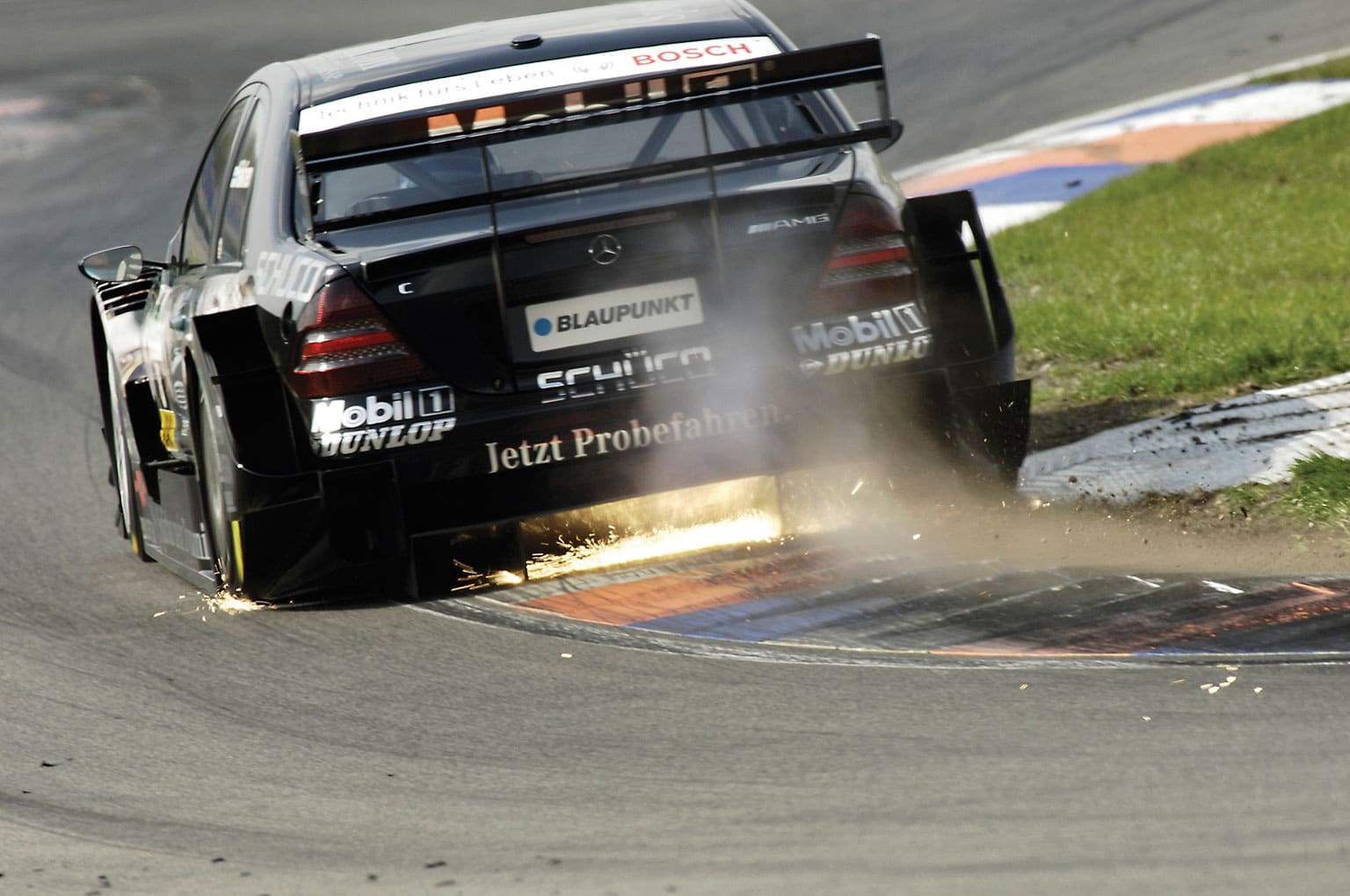
After F1 came the DTM with Mercedes – this is the fearsome Eurospeedway Lausitz in 2005
Motorsport Images
From 1995 McLaren’s deal with Mercedes came on stream, with the MP4/10. Nigel Mansell was returning to F1 as Mika’s team-mate but, as history relates, it didn’t work out. After two races, Mansell was replaced by Mark Blundell. There were teething troubles with the new engine and a lot of retirements, but Mika was second at Monza and Suzuka. “Then came Adelaide, and everything turned upside down.”
*
It was November, the final race of the season, and the last time Adelaide was used for the Australian Grand Prix. During Friday afternoon’s qualifying, in a quick right-hander, Mika’s left rear punctured. At 120mph the McLaren plunged into the tyre barrier. The concrete wall behind it was shifted back a foot. Mika’s head smashed down against the steering wheel and then bounced against the cockpit sides. The steering wheel was broken, and its buttons imprinted holes on his helmet. “I remember being in the wall. I couldn’t move my legs and arms, I couldn’t focus. I thought, OK Mika, just relax, don’t fight it, don’t panic, everything is going to be OK. Then I was gone, I don’t remember any more.”
While the medical car, with Professor Sid Watkins on board, was still speeding towards the scene, the two doctors at that corner got to the wrecked McLaren within seconds. Jerome Cockings, an intensive care specialist, and Stephen Lewis, a neurosurgeon, found Mika unconscious in the cockpit, losing a lot of blood from his mouth. With the marshals carefully supporting his head and neck they got him out of the car and laid him on the ground. Due to the trauma his mouth was locked shut, and they could not get oxygen into him to ventilate his lungs. Without oxygen, brain damage occurs within a couple of minutes, followed by death, and Mika was starting to turn blue. Taking a surgical knife from his kit, Cockings quickly performed a tracheotomy, inserting a tube into Mika’s throat to deliver oxygen. Immediately his colour improved and his condition stabilised. Then they were able to get a drip into him, and drugs to relax the muscle spasm and get a tube into his mouth. Prof Watkins was there by now, watching but not interfering, realising that the right things were being done. Eventually Mika was lifted into an ambulance and taken to the Royal Adelaide where his head was scanned – among other injuries, he had a fractured skull – and he was placed in intensive care. He regained consciousness the next day.
“I was lying there with tubes everywhere, so I knew I was in a hospital. The first person I saw was Lisa Dennis, then Ron’s wife, this tall figure by the bed with blonde hair and a big smile, and I thought she must be an angel. Then I saw Ron standing next to her, and I thought, OK, I am not in heaven yet. I tried to understand from Ron what had happened. I wanted it not to be my mistake. That’s an automatic thing a driver thinks. He told me it was a puncture.
“Then the hell started because I was in hospital in Australia for weeks. The doctors did a great job, and I know they saved my life where the accident happened, but I had so many tests and operations. Crazy tests, needles in my face to test the nerves, drilling a hole in my head to relieve the pressure, things like that. It was nasty. At first, because of the pain, I was thinking, ‘I’m going to die, I’m going to die.’ My whole life was looking at my watch to see when was it time for them to turn the valve in my drip for the next dose of drugs. The accident had damaged the nerves in my face and I couldn’t move my eyelids, so they had to tape my eyes shut to help me try to sleep. I couldn’t drink properly because my mouth didn’t work, so the water just fell out of my mouth. It was disgusting. I remember thinking, ‘This doesn’t look good.’ It wasn’t, ‘Will I be able to race again?’ It was, ‘Will I ever be able to live a normal life?’
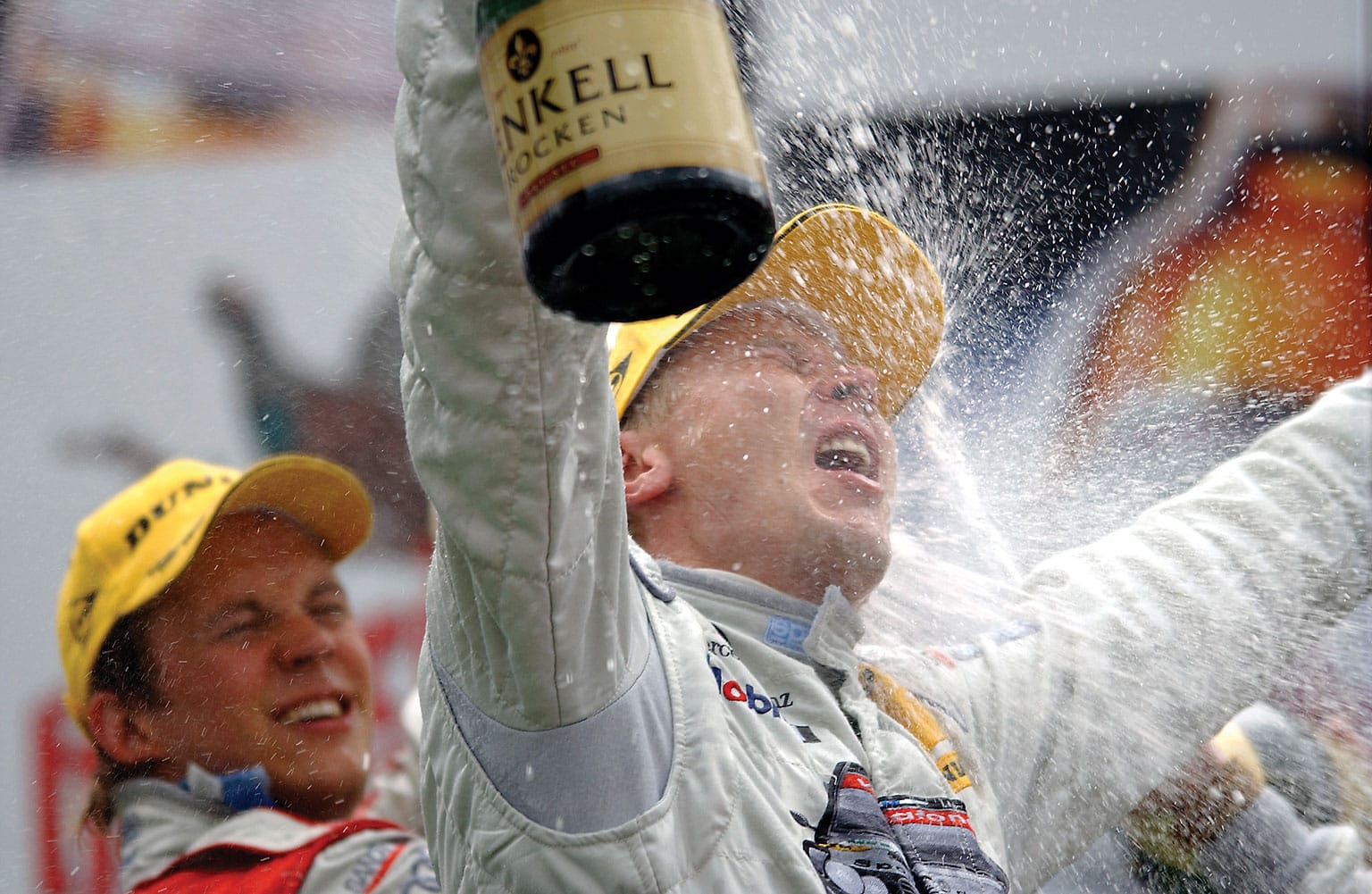
Victory followed soon after at Spa
Motorsport Images
“Finally I was able to walk in the garden, carrying my drip bottles, my head shaved like some bloody hooligan. I tried to look at things, the weather, the trees, the birds, but all I could think about was my next dose of painkillers. But I had great support from everybody, my girlfriend, my parents, my manager Didier Coton. My fitness trainer stayed all the time, because I didn’t want to be alone at night.”
Mika returned to London in December, with Stephen Lewis looking after him on the flight. He had more surgery under Prof Watkins, and then returned to Monaco and started the long haul back to fitness. “The whole recovery was difficult. I really had to fight every day to get back, physically and psychologically. Soon I started running, even though I was still getting massive headaches. I knew I was getting better and better, and eventually Prof said, ‘OK Mika, you can do a test.’ I still had problems with my face and with my hearing – I’d had a couple of ear operations – but I went to Paul Ricard.”
It was Monday February 5th, 87 days after the accident. “When I arrived everything was friendly, but I saw how the mechanics looked at me. I tried to behave like the normal Mika, but I knew they were thinking, ‘He won’t be able to do it, he’ll have to go back home.’ I thought, I’m going to show these guys, I’m coming back to win. When I got in the car I felt, this is my home, this is my office, and I went for it.” He did 63 laps, the best of which was half a second faster than Schumacher’s Ferrari had done the previous day. “I finished the test, said to the mechanics, ‘It’s fine. Pack up the car, take it back to England. I’ll see you in Melbourne.’”
Mika’s new team-mate was David Coulthard, and at first relations between the two weren’t easy. “It was my fourth season with McLaren, I knew the mechanics, I knew the management, they knew me. David came in very confident from Williams, he’d already won a GP. We had a different mentality, he was younger than me, much more outgoing, speaking to everybody. I also knew he was a very fast driver, so he was a threat. He wanted to work with me but I kept my distance, the lesson I’d learned from Senna. I still had no victories, I was angry about that, angry with myself, angry with the team. One day he said to me, ‘Mika, don’t you like me?’ I said, ‘Of course I like you. See you tomorrow.’
“As it turned out, we were team-mates for six seasons. We had several incidents when we crashed into each other, which didn’t help – Estoril that first year, the first corner at Spa in 1999, there was something in Austria as well – all this put tension between us. That’s the nature of the sport. Nowadays I see him often, and we have a good laugh about it. I have respect for him, he has respect for me. David is an unbelievably positive character, a very straightforward guy. He doesn’t like bullshit.”
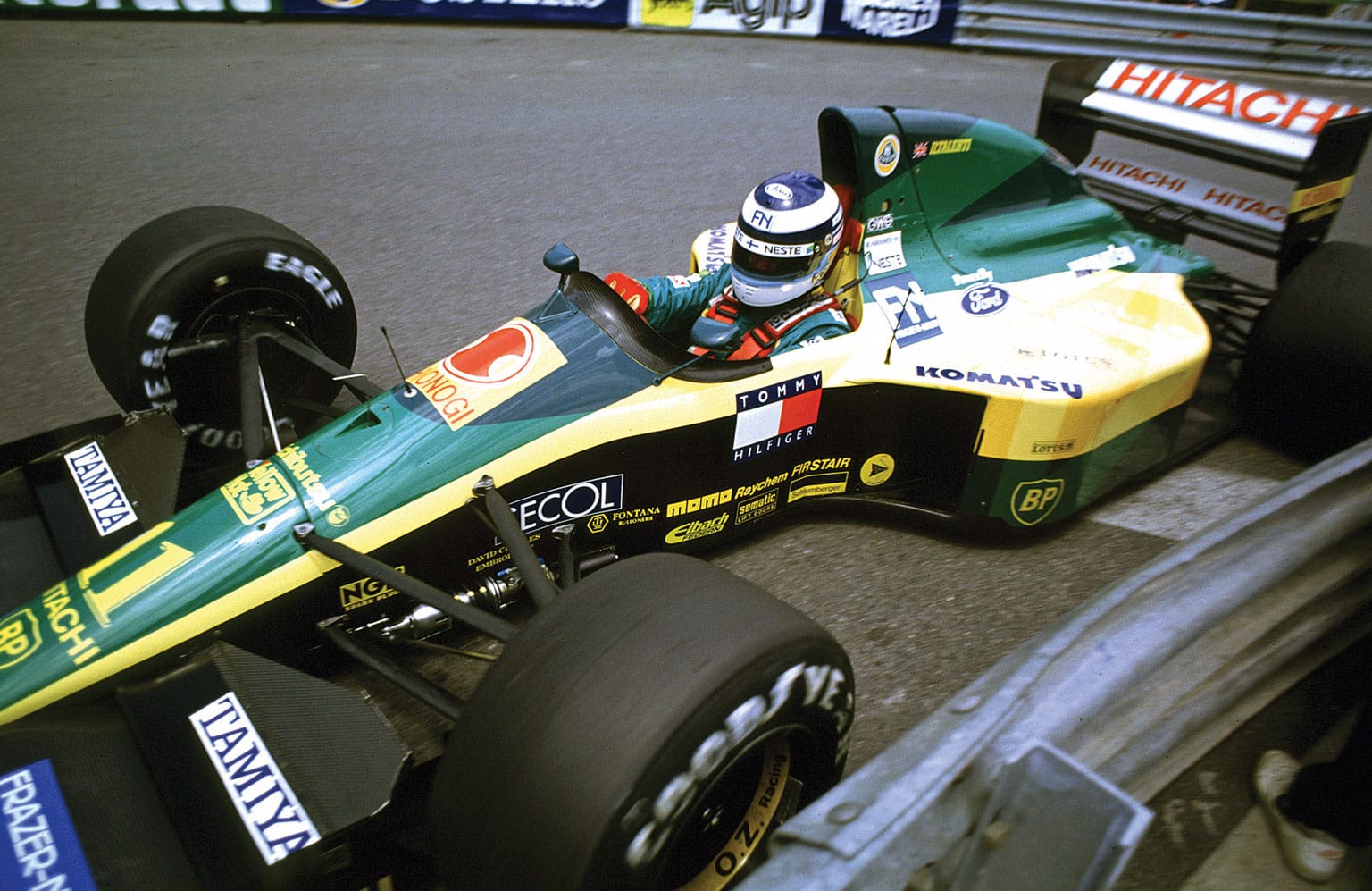
Mika got good results aboard the 1992 Lotus
Motorsport Images
In 1997 the McLaren MP4/12 started to win. But the first two victories went to Coulthard. Mika led at Silverstone, but his engine blew; he led at Monza, fell back because of a tyre problem, set fastest lap. At the Nürburgring he was the moral victor, leading from pole until a late engine failure. “I was thinking, I don’t believe this. What must I do to win a race?” At Jerez, the final round, McLaren ran a strategy to keep clear of the Schumacher/Villeneuve title battle. As it turned out, that harmed Mika’s race more than David’s, so Ron Dennis asked the Scot to let the Finn past in the closing laps. When Villeneuve slowed at the end, Mika had won a Grand Prix at last – at his 99th attempt. “I didn’t really win that race by racing. But next day I looked at the results and my name was first, so I thought, ‘OK, I’ll take that gift.’
Then the real wins started to come. “Adrian Newey joined the team, and he was so clever. You’d talk to him about how the car felt, and he’d understand at once what you were saying, write it down, start drawing and calculating. I had no idea what it all meant but it made the car faster. Of course it’s not just him, he needs good guys around him. But he is a truly great designer.”
The ’98 season produced a battle royal between Schumacher and Häkkinen. Michael won six races, Mika eight. Mika started from pole nine times, Schumacher three. Mika took the title by winning the final race in Japan, but the crucial day was the penultimate round at the Nürburgring. The rivals arrived at the race level on points, and Mika came through brilliantly to beat Michael in a straight fight.
With McLaren’s first titles since Senna in 1991, Dennis’ faith in Mika was finally vindicated. “Ron is a different guy. He has a special way of doing things, a way which takes a lot of balls. A lot of people don’t understand him, but I think pretty much everybody admires him. I was close to Ron and Lisa and the family, I watched their kids grow up, and Ron saw my commitment to the team. I never wanted to let him down. When the accident happened he stood by me, he still believed in me, and that made my confidence in him and the team even higher.
“In 1999 the regulations changed a bit. Adrian built a car that was more on the limit, we had a few technical problems. Then Michael had his crash at Silverstone and missed six races. I like to believe that if Michael had been there I’d still have won the title, but the satisfaction wasn’t the same.” In the end Mika only beat Ferrari’s Eddie Irvine by two points, scoring five wins but losing two more after accidents when leading. “At Imola our strategy was two stops. Every lap had to be a qualifying lap. I was pulling out the advantage I needed, got on the kerb too much, lost the back end, hit the wall. The only person I can blame is myself. At Monza, same thing, I am leading, I crash. That time there were other factors: I selected the wrong gear, my mistake, but the transmission locked up, which it shouldn’t have done. But in Japan everything worked OK.” Schumacher was back by then, and finished second, but wasn’t able to keep Mika out of the win and his second title.
“Those two title years were a lot of pressure. And, four years after the accident, I was still not totally recovered, still having headaches. After the race in Suzuka I was having dinner with Ron, Norbert [Haug of Mercedes] and David, and I said to David, ‘I’m completely exhausted, knackered. I can’t handle it any more. You’ll have to win the title next year.’”
But, come 2000, Mika was right back on form, once more battling for the title with Schumacher. He won four rounds, and was leading two more when the car failed. They arrived at the Belgian GP with Mika two points ahead, and their battle was one of F1’s most memorable. Both were on the limit around Spa’s daunting sweeps and swoops. Häkkinen wound Schumacher in, but the Ferrari driver blocked his every move. On the climb up from Eau Rouge, at around 205mph, Mika attacked, and the Ferrari moved over on him. On the next lap, storming up the same straight, backmarker Ricardo Zonta was in the way. Schumacher went left of him, so Häkkinen dived right – and had the inside line for the right-handed entry to Les Combes. It was a startlingly audacious move, and Michael had no answer for it. Mika won the race by 1.1sec.
“I had a tough time with Michael that day. He put me on the grass not once, but several times, at over 300kph. If I’d lost it I would really have got hurt. So I was angry like hell. What he did just motivated me more. I was ahead in the championship, and I think he was desperate. After the race I went to talk to him. But with Michael that doesn’t help, he is what he is. I’d known him since F3. He was a hard racer, well that’s OK. You play some tricks, go to the limit of the rules, but you don’t look in the mirror and then move to where the guy is coming. I don’t want to go back in history and say, ‘He is always the bad guy’, but he had incidents with Damon [Hill], incidents with Jacques [Villeneuve], the list is long.”
Schumacher took the 2000 title, Mika was runner-up. He won two more races in ’01: the US GP at Indianapolis and Silverstone, where he’d always had bad luck. Both times he beat Schumacher into second place. He had the Spanish GP in the bag, once again ahead of Schuey, when his clutch went on the last lap.
But he’d started the season with another big accident in Australia. “I was running second [to Schumacher!] and at 280kph the front upright broke and the suspension collapsed. I was totally out of control and I saw the barrier coming at me at 280kph. I had time to think, ‘Here we go again’, then bang! Marks on my crash helmet again, the taste of blood in my mouth, and I’m thinking, Mika, is this really clever? Luckily it was just a big bang on the head. But that was the first race of the year, with the whole season still in front of me.
“I still had the motivation to do it, but it was like I was writing a book, and my pen was gradually running out of ink. I’d come back from my accident, made myself strong again, won victories and championships, and now I said to Ron, ‘I’m not doing you a favour here. I’m still fast, I’m still winning, but you want a smiley driver who will motivate the mechanics, and I can’t do it any more. I’m getting tired.’ Ron said, ‘Don’t retire. Have a year off, see your friends, have a nice time.’ So I did that in 2002, and then I said to Ron, ‘I still feel the same.’
“But still I had offers. Williams talked to me about a comeback, and I was thinking that over when I saw Jackie Stewart in the Monaco paddock. He said to me, ‘Mika, once you’ve stopped, never come back.’ I smiled and said, ‘Yeah, yeah’, but inside I thought, he doesn’t just say this for fun. I thought it all through, the good points, the bad points, and I made my decision: no F1 comeback.
“So I did three seasons in DTM [the German touring car series]. Much safer than F1, and I loved it. Great sport, great people, great cars to race. I had a few wins – including Spa – and I enjoyed it. I’ve done some rallying too, but that was just for fun.
“Now I work with Didier in Aces Management here in Monaco, and we help a good list of young drivers. They all show potential, maybe some will get to F1. Also I am brand ambassador for several sponsors. I keep fit, although if I do strenuous sport the headaches come back. I take my two children to school. My son Hugo, who is nine, he is doing karting now. Of course he’s brilliant, but that’s coming from his dad. I still keep up with F1. I have a good relationship with all those people still, go to maybe five races a year. But I’m not in that world now. Yesterday has gone. Nigel came back, but it didn’t work for him. Michael came back: what do I think about that? Well, that’s another story…”
